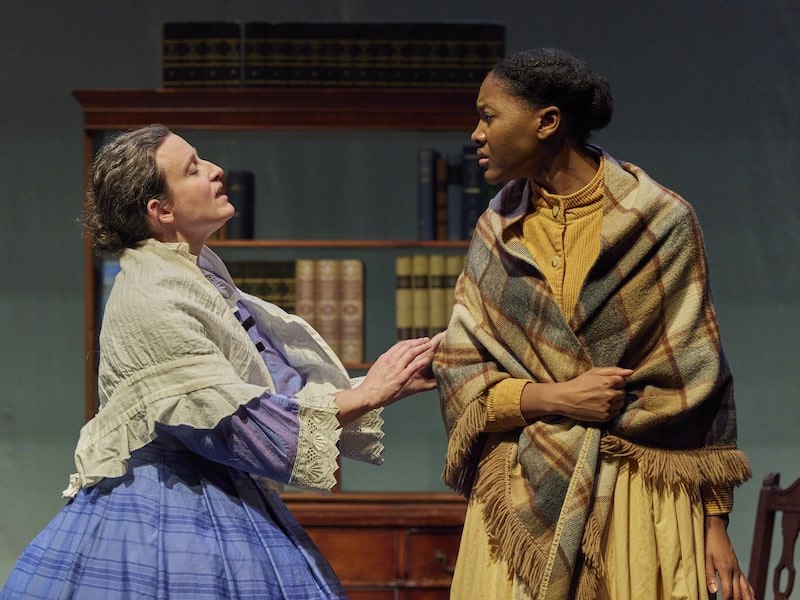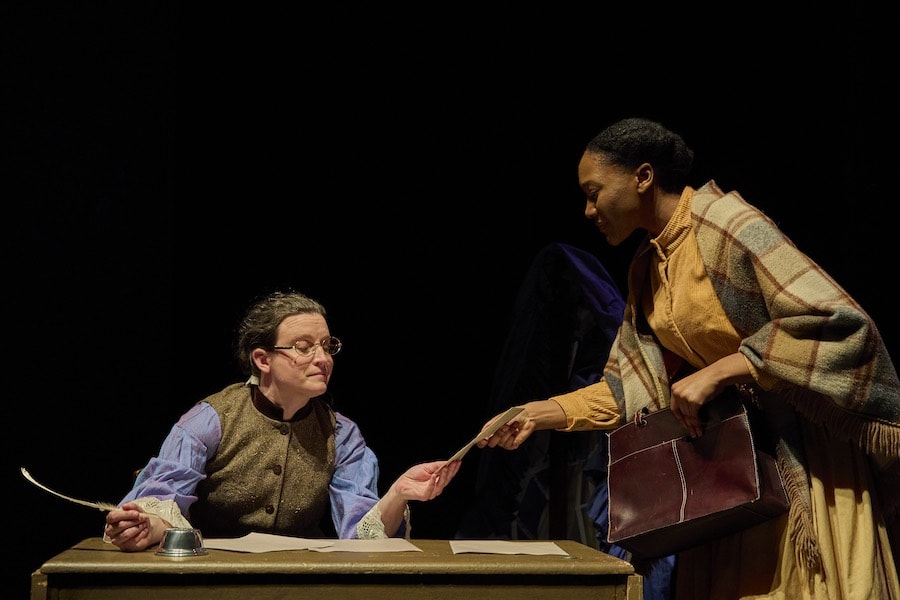The most powerful theatrical image in The Storehouse — a new two-actor play by Joanna Castle Miller being given its world premiere by Perisphere Theater — is its first. Hiding from an abusive enslaver, Harriet Jacobs (Ahdis Beruk), is curled up inside a cramped “garret” in her grandmother’s house. She recites portions of the Fugitive Slave Act.
Downstage, Harriet Beecher Stowe (Allison McAlister), a devout Christian and a member of a well-connected family prominent in the Protestant church of the era, prays fervently while holding her infant son. The child dies, leaving Stowe distraught.
The remainder of the play examines how Stowe and Jacobs, and their approach to writing in support of the abolitionist cause, might have interacted. It’s an important discussion and, while further work to hone Castle Miller’s script could be useful, one that is worthy of an audience’s attention.

A word about the two women. Stowe, a white woman, (1841–1896), is remembered as the author of the 19th century’s bestselling novel, Uncle Tom’s Cabin (1852), which mobilized the emotions of much of the country against the evils of slavery, while giving rise to heated rebuttals from pro-slavery writers.
Jacobs, a Black woman (1813–1897), endured sexual harassment from an enslaver and spent seven years hiding in that cramped garret, before escaping to the North, where she made important contacts in the abolitionist community, including Frederick Douglass and prominent white antislavery activists like Amy Post. Jacobs is best known for her autobiographical work, Incidents in the Life of a Slave Girl (1861), the power of which has been compared to Douglass’ autobiographies. Jacobs’ life and work are less known today than that of Stowe or Douglass, an omission the play endeavors to correct.
Their formative experiences profoundly influenced both women’s writings. For Stowe, the loss of her son put her in mind of the grief of enslaved mothers forcibly separated from their children. The “storehouse” of the play’s title is Jacobs’ life experience, which is the subject of her book.
There is a kernel of historical truth concerning the fraught interaction between the two that is central to The Storehouse. On two occasions, Stowe rebuffed overtures from Jacobs, through an intermediary or in writing, to help her efforts to tell and publish her story.
Castle Miller structures the play around fictional in-person encounters, happening over several years, in which Stowe and Jacobs spar over their contrasting views of how stories should be written and who should tell them. In this context, the play addresses significant issues around race and gender. Stowe faces initial opposition from her husband (impersonated briefly by Beruk) to her literary ambitions. In the absence of enforced copyright protections, Stowe loses control of the characters she created to a variety of outlandish and offensive theatrical versions of her novel. In an effective scene in the second act, Stowe unsuccessfully confronts P.T. Barnum (Beruk sparkles in that cameo) about his “Tom Show.”

As a Black woman, Jacobs faces far higher hurdles. “Intersectionality” was not a 19th-century term, but the combination of race- and gender-based obstacles to Jacobs’ ability to tell her own story is an important theme of the play.
Stowe initially prefers to incorporate Jacobs’ story into her own writing, rather than letting it be told independently in Jacobs’ own voice. Stowe’s abolitionism and progressive views on subjects like women’s suffrage coexist with racist stereotypes of Black people, and, at least implicitly, she does not regard Jacobs as her equal.

In one scene, a fussy, Shakespeare-quoting publisher (McAlister, in the best comic moment in an otherwise highly serious script) insists on having Jacobs’ words validated through an endorsement by a better-known, white author, like Stowe. A key point in Jacobs’ story — her sexual relationship with a white man, which she engaged in to avoid the more predatory attentions of another white man — is a source of embarrassment to her and discomfort for Stowe, given Stowe’s commitment to the ideal of pure, virtuous Christian women.
McAlister nicely digs into the nooks, crannies, and contradictions of the character. The play characterizes Stowe as an always busy, energetic woman, jumping from one thing to the next, very determined to do things her way, expressing a style of 19th-century spirituality involving not only Protestant piety but visions of spirits, like that of her husband’s deceased first wife, whose portrait hangs in her study.
In Beruk’s portrayal, Jacobs gains confidence and strength as the play proceeds. In playwright Castle Miller’s script, Jacobs comes across as unbreakable, determined, proud, and willing to take profound risks for her freedom. I found myself wishing that the playwright had given the actor even more to work with.
The technical side of the production is simple. An upstage platform serves as the office in Stowe’s home. Two small downstage areas are used for short scenes with other characters (Mykal Bailey was the scenic designer). The area lighting (Reed Simiele) is serviceable. The sound design, not credited in the program, is rather odd, with present-day pre-show and intermission music and repeated drum rolls during sometimes-lengthy intervals between scenes.
As may often be the case with a new play, some reshaping and tightening of the script could be beneficial to future productions. The interchanges between Stowe and Jacobs are often wordy, and variations on similar disagreements become repetitious at times. The characters often exchange statements rather than engage in conversation. Under the direction of Amberrain Andrews, there is often little movement within scenes; the characters stand or sit and talk. The overall pace is languid, and the play, with its hour-and-ten-minute first act and much shorter second act, might profitably be condensed into a 90-minute one-act.
The final scene of the play shifts into a sort of magical realism, as Stowe and Jacobs stage a debate before an imagined audience of present-day college students, pitting the merits and relevance of their respective books against each other.
While Uncle Tom’s Cabin has always been problematic in terms of its portrayals of Black characters told from the viewpoint of a privileged white woman, its historical impact is undeniable: In the mode of a sentimental melodrama of epic scope, it focused the national debate about slavery in a way that no other work had done. First-person narratives like Incidents in the Life of a Slave Girl are invaluable in showing the daily reality of what it meant to be an individual enslaved person. The play’s final scene, perhaps in the interest of sharp dramatic conflict onstage, casts these differing perspectives as antagonistic. But are they not also complementary in the real world? That’s a question a future iteration could perhaps explore.
Running Time: Two hours and 5 minutes, including one intermission.
The Storehouse plays through March 25, 2023, presented by Perisphere Theater performing at the Silver Spring Black Box Theatre, 8641 Colesville Road, Silver Spring, MD. (If you are driving, allow time for parking, which is tight in the area.) Tickets, priced at $34 (with senior and student discounts available), may be purchased online or at the door.
COVID Safety: Masks must be worn at the facility at all times except when actively eating or drinking. See the venue’s COVID-19 policy here.




